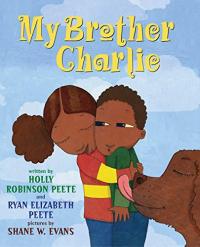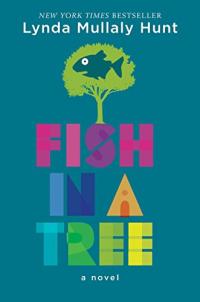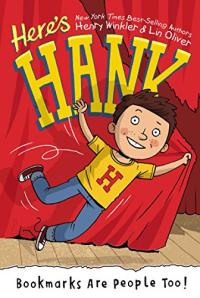
The year is 1862, and 12-year-old P.K. “Pinky” Pinkerton is on the run from Whittlin’ Walt and his gang of ruthless desperados. P.K. is determined to hold on to Ma’s last priceless possession: the deed to a large amount of land and silver mines in the Nevada Mountains. P.K. will have to be both clever and cunning to evade the band of outlaws. All this is seen through the eyes of P.K., a half-Lakota kid with Asperger Syndrome, which makes him chronically unable to interpret the intentions of people around him.
P.K. Pinkerton and the Case of the Deadly Desperados

Fourth grade is not going at all how Benny Barrows hoped. He hasn’t found a new best friend at school. He’s still not a great bike rider — even though his brother George, who’s autistic, can do tricks. And worst of all, he worries his dad’s recent accident might be all his fault. Benny tries to take his mom’s advice and focus on helping others, and to take things one step at a time, but Benny doesn’t know how he and his family will overcome all the bad luck that life seems to have thrown their way.
Just My Luck

Charlie’s perfectly ordinary life has been unraveling ever since his war journalist father was injured in Afghanistan. When his father heads from California to Virginia for medical treatment, Charlie reluctantly travels cross-country with his boy-crazy sister, unruly brothers, and a mysterious new family friend. This story is equal parts madcap road trip, coming-of-age story for an autistic boy who feels he doesn’t understand the world, and an uplifting portrait of a family overcoming a crisis. See our interview with the author, Sally J. Pla ›
The Someday Birds

This uplifting story follows space-obsessed Lester Musselbaum as he experiences the challenges of his first days of public school: making friends, facing bullies, finding his “thing,” and accidentally learning of his autism-spectrum diagnosis. A touching peek into the life of a sensitive autism-spectrum boy facing the everydayness of elementary school.
Superstar

Twins Callie and Charlie have a lot in common, but they are also very different: Charlie has autism. Callie narrates the story, describing what autism is and exploring the issues that come along with it. The theme is of love, patience, and acceptance. Endnotes give a few basic facts for children unfamiliar with autism. The authors, a mother-daughter team, based this story on personal experience. The bright, mixed-media illustrations depict the family’s warmth and concern.
My Brother Charlie

Four very different kids each with unique problems and personalities, come together over a short period to find a lost boy, come to appreciate each other, and discover new friendships. Each character is recognizable, likeable, and when they come together create a fast-paced story sure to engage young readers.
Hello, Universe

After the mother skunk is killed, Bixby “Bat” Alexander Tam’s veterinarian mother brings home its kit to be kept only until its old enough to be released. Who would have thought Bat would want to keep the baby skunk, named Thor? Is it really okay for a skunk to become a pet? Bat is a unique character and the story offers a deeply heartfelt glimpse into the life of a boy on the autism spectrum, presented realistically in this touching (and surprisingly informative) novel.
A Boy Called Bat

When he was born, he had a face that even his mother had trouble loving. But Hoge eventually came home, survived multiple operations, and gained a strong sense of self. This is a touching, true story told by the Australian who has gone on to lead a successful and full life. It is told with humor, pathos, and an appreciation of what is truly important.
Ugly

Archer has been in two weddings. He looks back on the first one — a disaster for the then six-year-old boy. At least Archer met Lynette Stanley, starting a friendship that has stuck. Now in 6th grade, Archer confronts bullies and what it means to be a man as he matures. Quirky characters combine with poignant and laugh-out-loud scenes in this memorable and ultimately touching novel.
Best Man

11-year-old Genie and his soon-to-be-14-year-old brother, Ernie, travel from their home in Brooklyn to spend the summer in rural Virginia with their grandparents. The boys are in for lots of surprises; they learn that their grandfather is blind, that there is no Internet, and more. Characters are distinct and vividly depicted as Genie narrates his satisfying story.
As Brave As You

This fictionalized account of how young Louis Braille lost his eyesight is told through his voice. It is realistic but with lighter touches as well as insight into what inspired him to invent a way for blind people to read. Illustrations augment the information and tone to engage and enlighten readers.
Six Dots: A Story of Young Louis Braille

Look over the ledge with the child watching other kids play far below. What does she see? When they look up and see her, she is joins them below with the promise of friendship. Aerial views and limited text make this visual experience memorable, especially when we see the child who watched from above; her wheelchair does not impede her at all.
Look Up!

In this funny, poignant graphic novel memoir, Bell chronicles her hearing loss at a young age and her subsequent experiences with the Phonic Ear, a very powerful — and very awkward — hearing aid. The Phonic Ear gives Cece the ability to hear — sometimes things she shouldn’t — but also isolates her from her classmates. After some trouble, she is finally able to harness the power of the Phonic Ear and become “El Deafo, Listener for All.” And more importantly, declare a place for herself in the world and find the friend she’s longed for.
El Deafo

Even though she’s a math whiz, sixth grader Ally struggles to make sense of words on a page — that is until she meets Mr. Daniels. Ally discovers that she has dyslexia. Mr. Daniels is studying for a degree in helping children learn to read using different techniques — which open Ally’s world in many ways. Based on the author’s own experiences, Ally’s voice is successfully used to create a realistic and touching novel.
Fish in a Tree

Hank is a second-grade kid who doesn’t try to be funny, but he somehow always makes the kids in his class laugh. He’s pretty bad at memorizing stuff, and spelling is his worst subject. (But so are math and reading!) Hank’s class is putting on a play, and Hank wants the lead part: Aqua Fly. But he freezes in his audition and can only buzz like a fly. His teacher creates a special part for Hank, a silent bookmark. This may seem like an insignificant role, but when his enemy, Nick McKelty, freezes during the performance, it’s up to Hank to save the play! This is the first book in the Here’s Hank series.
Bookmarks Are People Too! (Here’s Hank)

Even though Emily’s teacher is distressed that Emily daydreams during science, both recognize that Emily’s wandering mind just might lead to creativity and new ways of thinking. A lighthearted take on a serious topic reminds readers that imagination can lead to many positive things.
Free Association: Where My Mind Goes During Science Class

The narrator awakens early on the most exciting day of the year. It is Basant, a day to celebrate a new season with kite-flying and kite-fighting from the rooftops of Lahore. Rich mixed media illustrations add texture to the vivid and discussable story of the kite-flyer who is in a wheelchair but not limited as he becomes king from his rooftop.
King for a Day

Anne Sullivan arrived at the Keller home in 1887, writing letters to a friend about how she worked with a deaf and blind girl named Helen. Anne’s words combine with a straightforward narration and gentle illustrations to provide deeper insight into how Helen Keller grew into a brilliant woman.
Annie and Helen

The story of Louis Braille, the Frenchman who invented the raised-dot alphabet/code now used around the world by blind and visually impaired readers. The text traces Braille’s life from the childhood accident that caused him to lose his sight through his career at the National Institute for Blind Children in Paris. Readers can feel the alphabet and numbers from 1-10 at the back of the book.
A Picture Book of Louis Braille

William Hoy wasn’t born deaf but lost it as a boy growing up in rural Ohio. In spite of his hearing loss, Hoy went on to become a remarkable major league baseball player at the end of the 19th century. His little known story is sure to inspire contemporary readers who will meet him in this handsome, detailed picture book biography.
Silent Star: The Story of Deaf Major Leaguer William Hoy

Nothing is the way it’s supposed to be when you live on an island with a billion birds, a ton of bird crap, a few dozen rifles, machine guns and automatics and 278 of America’s worst criminals. And then there’s Moose Flanagan. Moose’s father works as a prison guard and his family lives on the east side of Alcatraz — not far from the mobster Al Capone.
Al Capone Shines My Shoes

When Moose’s family moves to Alcatraz so his father can work as a guard and his sister Natalie (who has autism) can attend a special school in San Francisco, Moose has to leave his friends and his winning baseball team behind. Moose just wants to protect Natalie, live up to his parent’s expectations, and stay out of trouble, but on Alcatraz, trouble is never very far away.
Al Capone Does My Shirts

Fourth grader Donovan (introduced in Donovan’s Word Jar (opens in a new window)) learns to cope with the change in his favorite uncle (who lost both legs in the war), with having difficulty in school, and more — all’s possible with the help of his supportive and involved family.
Donovan’s Double Trouble

Her “travelin’ eye” doesn’t bother the narrator at all but it does mean that she has trouble focusing in school. The patch and eyeglasses prescribed by the ophthalmologist give her classmates something to tease her about — until she makes them her own fashion statement. Naïve illustrations are eye-catching and capture the child’s world, what she sees, and how she sees it.
